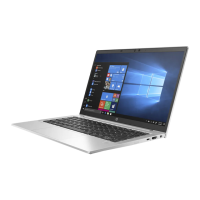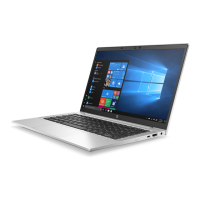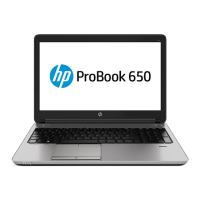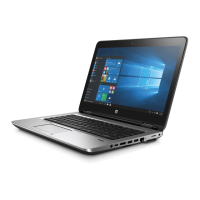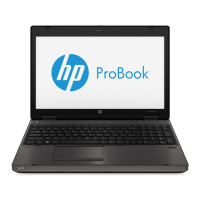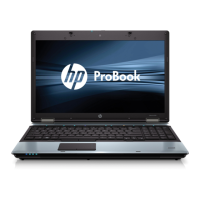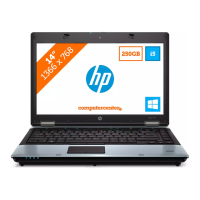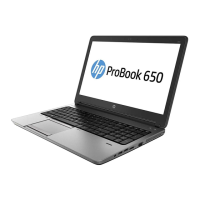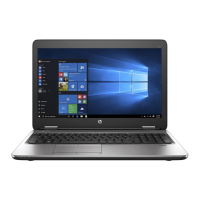Do you have a question about the HP ProBook 6360b and is the answer not in the manual?
Details of Intel Core i7, i5, and Celeron processors.
Covers memory module slots and RAM support up to 16 GB.
Lists supported SATA HDD and SSD capacities and speeds.
Outlines WLAN and WWAN module options and formats.
Lists various input/output ports like USB, DisplayPort, RJ-45.
Covers fingerprint reader, Smart Card reader, and TPM.
Lists supported Windows and Linux operating systems.
Identifies display switch, WLAN/WWAN antennas.
Details pointing devices, touchpad, and buttons.
Explains the function of various indicator lights on the laptop.
Identifies power, wireless, QuickWeb, and fingerprint reader buttons.
Explains the function of keyboard keys like Esc, Fn, and Num Lock.
Identifies front-facing ports and indicators like release latch and drive light.
Identifies security cable slot, network jack, USB ports, ExpressCard slot.
Identifies audio jacks, USB ports, and display ports.
Identifies audio ports, USB, DisplayPort, and external monitor port.
Identifies battery release, docking connector, SIM slot, and bays.
Locates WLAN and WWAN antennas within the display assembly.
Explains how to identify product name, serial, part number, and warranty.
Provides an exploded view and part numbers for main components.
Lists parts specific to the display assembly.
Details the spare part number for plastic components.
Lists components included in the cable kit.
Lists optical drive and hard drive options with part numbers.
Cross-references part numbers with descriptions for easier ordering.
Outlines necessary tools and general precautions for disassembly.
Explains electrostatic discharge (ESD) and prevention methods.
Provides steps for removing and installing the laptop battery.
Explains the procedure for removing the computer's bottom cover.
Details the steps for removing and installing the Wireless LAN module.
Provides instructions for removing and installing the optical drive.
Explains how to remove and install a drive from the upgrade bay.
Details the procedure for removing and installing the main hard drive.
Explains how to remove and install RAM modules.
Explains how to remove and install the CPU, including thermal material.
Explains the complex process of removing and installing the main system board.
Details the steps for removing and installing the entire display assembly.
Instructions on how to launch the BIOS/Setup utility.
Explains navigation, selection, and saving changes within the utility.
Overview of the File, Security, and System Configuration menus.
Lists physical dimensions, weight, power, temperature, and environmental specs.
Details display dimensions, resolution, brightness, and viewing angles.
Lists specifications for various HDD/SSD capacities.
Technical details for the optical drive's read/write capabilities.
Procedures for backing up and recovering data on Windows 7.
Procedures for backing up and recovering data on Windows Vista.
Procedures for backing up and recovering data on Windows XP.
General electrical and physical requirements for power cords.
Country-specific agency approvals and cord types.
Guidelines for proper battery disposal at end-of-life.
Instructions for disassembling the display assembly for recycling.
Details of Intel Core i7, i5, and Celeron processors.
Covers memory module slots and RAM support up to 16 GB.
Lists supported SATA HDD and SSD capacities and speeds.
Outlines WLAN and WWAN module options and formats.
Lists various input/output ports like USB, DisplayPort, RJ-45.
Covers fingerprint reader, Smart Card reader, and TPM.
Lists supported Windows and Linux operating systems.
Identifies display switch, WLAN/WWAN antennas.
Details pointing devices, touchpad, and buttons.
Explains the function of various indicator lights on the laptop.
Identifies power, wireless, QuickWeb, and fingerprint reader buttons.
Explains the function of keyboard keys like Esc, Fn, and Num Lock.
Identifies front-facing ports and indicators like release latch and drive light.
Identifies security cable slot, network jack, USB ports, ExpressCard slot.
Identifies audio jacks, USB ports, and display ports.
Identifies audio ports, USB, DisplayPort, and external monitor port.
Identifies battery release, docking connector, SIM slot, and bays.
Locates WLAN and WWAN antennas within the display assembly.
Explains how to identify product name, serial, part number, and warranty.
Provides an exploded view and part numbers for main components.
Lists parts specific to the display assembly.
Details the spare part number for plastic components.
Lists components included in the cable kit.
Lists optical drive and hard drive options with part numbers.
Cross-references part numbers with descriptions for easier ordering.
Outlines necessary tools and general precautions for disassembly.
Explains electrostatic discharge (ESD) and prevention methods.
Provides steps for removing and installing the laptop battery.
Explains the procedure for removing the computer's bottom cover.
Details the steps for removing and installing the Wireless LAN module.
Provides instructions for removing and installing the optical drive.
Explains how to remove and install a drive from the upgrade bay.
Details the procedure for removing and installing the main hard drive.
Explains how to remove and install RAM modules.
Explains how to remove and install the CPU, including thermal material.
Explains the complex process of removing and installing the main system board.
Details the steps for removing and installing the entire display assembly.
Instructions on how to launch the BIOS/Setup utility.
Explains navigation, selection, and saving changes within the utility.
Overview of the File, Security, and System Configuration menus.
Lists physical dimensions, weight, power, temperature, and environmental specs.
Details display dimensions, resolution, brightness, and viewing angles.
Lists specifications for various HDD/SSD capacities.
Technical details for the optical drive's read/write capabilities.
Procedures for backing up and recovering data on Windows 7.
Procedures for backing up and recovering data on Windows Vista.
Procedures for backing up and recovering data on Windows XP.
General electrical and physical requirements for power cords.
Country-specific agency approvals and cord types.
Guidelines for proper battery disposal at end-of-life.
Instructions for disassembling the display assembly for recycling.
| Bus type | DMI |
|---|---|
| Stepping | J1 |
| Tjunction | 100 °C |
| Processor cache | 3 MB |
| Processor cores | 2 |
| Processor model | i5-2520M |
| System bus rate | 5 GT/s |
| Processor family | Intel® Core™ i5 |
| Processor series | Intel Core i5-2500 Mobile Series |
| Processor socket | Socket 988 |
| Processor threads | 4 |
| Processor codename | Sandy Bridge |
| Processor frequency | 2.5 GHz |
| Processor cache type | Smart Cache |
| Processor lithography | 32 nm |
| Processor manufacturer | Intel |
| Processor front side bus | - MHz |
| PCI Express slots version | 2.0 |
| Processor boost frequency | 3.2 GHz |
| Processor operating modes | 64-bit |
| ECC supported by processor | No |
| PCI Express configurations | 1x16, 2x8, 1x8+2x4 |
| Thermal Design Power (TDP) | 35 W |
| CPU multiplier (bus/core ratio) | 25 |
| Maximum number of PCI Express lanes | 16 |
| HDD speed | 7200 RPM |
| HDD interface | SATA II |
| Optical drive type | DVD Super Multi DL |
| Card reader integrated | Yes |
| Total storage capacity | 320 GB |
| Compatible memory cards | MMC, SD |
| Display diagonal | 13.3 \ |
| Display resolution | 1366 x 768 pixels |
| Native aspect ratio | 16:9 |
| Intel segment tagging | Enterprise |
| Memory slots | 2x SO-DIMM |
| Internal memory | 4 GB |
| Internal memory type | DDR3-SDRAM |
| Maximum internal memory | 16 GB |
| Audio system | SRS Premium Sound |
| Bluetooth version | 2.1+EDR |
| Networking features | Gigabit Ethernet |
| Operating system installed | Windows 7 Professional |
| Charging port type | DC-in jack |
| HDMI ports quantity | - |
| USB 2.0 ports quantity | 3 |
| CardBus PCMCIA slots quantity | 0 |
| Cable lock slot type | Kensington |
| Pointing device | Touchpad |
| Number of battery cells | 6 |
| On-board graphics card ID | 0x116 |
| Discrete graphics card model | Intel® HD Graphics 3000 |
| On-board graphics card family | Intel® HD Graphics |
| On-board graphics card base frequency | 650 MHz |
| On-board graphics card dynamic frequency (max) | 1300 MHz |
| Processor code | SR048 |
| Processor ARK ID | 52229 |
| Processor package size | 37.5 x 37.5 (rPGA988B); 31 x 24 (BGA1023) mm |
| Supported instruction sets | AVX |
| Intel Identity Protection Technology version | 1.00 |
| Country of origin | China |
| Depth | 220 mm |
|---|---|
| Width | 322 mm |
| Weight | 1900 g |
| Height (rear) | 34 mm |
